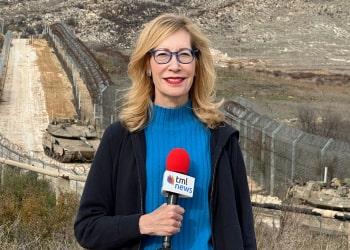While the blame-game is easy, holding Hamas accountable for the destruction of the Strip would go a long way to alleviating the plight of the Palestinians
The Gaza Strip is a perpetual war zone, plagued by recurring conflict between Hamas and Israel, which the Islamist terrorist regime is committed to destroy. The results have been as devastating as they are predictable, with some eighty percent Gazans fully dependent on international aid while their basic freedoms are brutally repressed.
According to Israel Defense Forces Chief of Staff Gadi Eisenkot, conditions in the Palestinian enclave have deteriorated into a full-blown humanitarian crisis that unless alleviated could prompt Hamas to again initiate a war, in a bid to deflect attention away from its own failings while placing Israel in the international community’s cross-hairs due to the inescapable military response. As such, the IDF’s top soldier is purportedly in favor of increasing aid to the Strip which could include, for the first time, the direct transfer of Israeli-made goods.
By contrast, Israeli Defense Minister Avigdor Liberman believes the situation in Gaza falls short of a humanitarian crisis—albeit with “difficult” circumstances—a position he emphasized is shared by the entire security establishment. This, notwithstanding Eizenkot’s contradictory statements a day earlier and against the backdrop of recent reports of the submission of a dossier to Prime Minister Binyamin Netanyahu in which senior army officials stressed that a further economic downturn in Gaza is inevitable and that war will ensue.
The internal Israeli debate comes after United Nations special envoy to the Middle East Nickolay Mladenov recently claimed at a Tel Aviv conference that Gaza was on the verge of “total collapse,” a development that “risks exploding in our face again, this time in a far more deadly and violent manner than in the past.” He stressed that in order to avert disaster, power in the territory should be shifted to Palestinian Authority President Mahmoud Abbas.
But apparently the Palestinian leader is not apprised of the situation, as he continues to maintain sanctions on Gaza in the wake of yet another failed reconciliation attempt with Hamas. Amid the intra-Palestinian dispute, Abbas only six months ago pressured Israel into reducing the amount of electricity it supplies to the Strip despite the prevailing economic circumstances.
This comes as the White House froze around $100 million to UNRWA, the UN agency for Palestinian refugees, after the PA announced it would no longer accept the U.S. as a mediator in peace talks with Israel. Approximately 1.3 million Gazans (about three-quarters of the population) are classified as “refugees” and are thus reliant, to various degrees, on UNRWA for food, schooling and employment.
This holiday season, give to:
Truth and understanding
The Media Line's intrepid correspondents are in Israel, Gaza, Lebanon, Syria and Pakistan providing first-person reporting.
They all said they cover it.
We see it.
We report with just one agenda: the truth.


In response, Russia, Kuwait and nine European countries—including Germany, Belgium and Switzerland—agreed to speed up their contributions to the UN body to help fill the shortfall.
The picture being painted is a confusing one, largely because the debate is subjective and often skewed by politics. The argument over Gaza’s economic woes also generally devolves into a blame-game, thereby obfuscating cause and effect, which, in turn, prevents the formulation of coherent policies to appropriately address the matter.
One element that warrants objective consideration is the Israeli-Egyptian blockade of Gaza, imposed after Hamas’ consolidation of power in 2007. This followed Israel’s unilateral disengagement from Gaza in 2005, in which the Jewish state uprooted every man, woman, child and soldier. One year later, Palestinians democratically-elected Hamas—in their last free vote since—which subsequently went about ejecting Abbas’ PA from the enclave in an internecine war.
Most observers agree that the blockade is the result of Hamas’ actions towards Israel and not some draconian “siege” implemented to induce misery. This is further evidenced by Israel’s attempt to allow normal economic relations between Gaza and its neighbors through the forging of the 2005 Agreement on Movement and Access, which would have kept open the border crossing with Egypt but was scrapped in the wake of an uptick of terrorism emanating from the Strip.
While Israel each day oversees the transfer of vast amounts of international aid through the Kerem Shalom crossing, Jerusalem is remiss to do more given that Hamas typically diverts funds and materials it receives towards enhancing its war machine rather than investing the resources in civilian projects. This largely accounts for the cycle of violence over the past decade, including three major military conflicts culminating in the 2014 conflict that decimated the enclave’s infrastructure.
As such, unconditionally increasing aid to Gaza—which is already the world’s largest per capita recipient of international assistance—will likely be tantamount to applying a Band-Aid to a gaping wound. At best it is a short-term stop-gap that will not bring about any major economic improvements or serve to prevent another round of fighting, the repeated outbreak of which is directly correlated to economic hardship.
According to the data compiled the Palestine Central Bureau of Statistics (PCBS), in the year following the eight-day November 2012 conflict between Israel and Hamas, Gaza’s real GDP fell from about 5% to about -7.5%. In 2014, when the latest and most severe war was waged, real GDP growth in the Strip was approximately -16%. Going further back, real GDP in Gaza ranged from -5% to -15% between 2000 and 2002, the height of the Second Intifada, the Palestinian terror war characterized by the suicide bombing of Israeli buses and cafes.
Otherwise, in non-conflict years Gaza’s real GDP has generally been positive, including a forecast of 3.5% for 2018. Even so, economists attribute the growth largely to foreign-funded reconstruction projects or donor aid, which are not long-term financial engines. This is made stark by the fact that Gaza’s unemployment rate has skyrocketed to about 40%.
So while Israeli restrictions have indeed exacerbated the situation, the facts suggest that Hamas’ aggression is the root cause of the destitution in the enclave. This, in turn, leads to Mladenov’s conclusion that Gaza requires political transformation, which, to date, has largely hinged on Palestinian reconciliation; that is, essentially the incorporation of Hamas into the rival Palestinian Authority.
The attempt late last year to end the divide included the stipulation that the terror group disarm, which would bring both the civilian and security apparatuses under the auspices of Abbas. There is no question that this would vastly improve the economic prospects in Gaza, first by bringing about political stability which is an economic driving force; and second by lowering the probability of a future conflict with Israel that effectively returns Gaza to square one. The problem, however, is that historical precedent—namely, repeated failed attempts to forge Palestinian unity—suggests the chances of this happening are slim to none, at least in the foreseeable future.
There are also those who believe that Gaza’s prosperity is ultimately dependent on a comprehensive Israeli-Palestinian peace agreement, which would likewise undoubtedly improve the quality of life on both sides. But this too is presently improbable, given Abbas has effectively boycotted Washington and is attempting to internationalize the negotiating process, a move which an already reticent—if not fully disinterested—Israeli government rejects. At this stage, most analysts agree that any movement on the peace front would be extremely limited, likely in the form of interim arrangements to incrementally improve conditions foremost in the West Bank.
Consequently, the most realistic option for Gaza may be for the international community to press for internal reform, a tactic hinted at this month by Defense Minister Liberman, who noted that Hamas spent $260 million in 2017 manufacturing rockets and constructing subterranean attack tunnels—funds that otherwise could have been used to build waste-management and water-purification facilities.
Similarly, American peace envoy Jason Greenblatt recently tweeted, “Imagine what the people of Gaza could do with the $100 million Iran gives Hamas annually that Hamas uses for weapons and tunnel to attack Israel!” Notably, the U.S. Treasury concurrently designated Hamas boss Ismael Haniyeh a terrorist, suggesting that Washington may be readying to clamp down on the Gaza regime. And while tightening the screws on Hamas might indeed prompt the terror group to lash out at Israel, most consider this an inevitability over the long-term given Hamas’ ideology and renewed backing by Tehran.
It may thus be that things will get worse in Gaza before they get better. And if this results in war, Israel might end the vicious cycle by finishing off Hamas once and for all. The key in such an eventuality is to prepare Gazans for the day after their freedom from bondage, which requires providing them not only with food and water but with the agency to pick themselves up by their own bootstraps and start to create a better future.